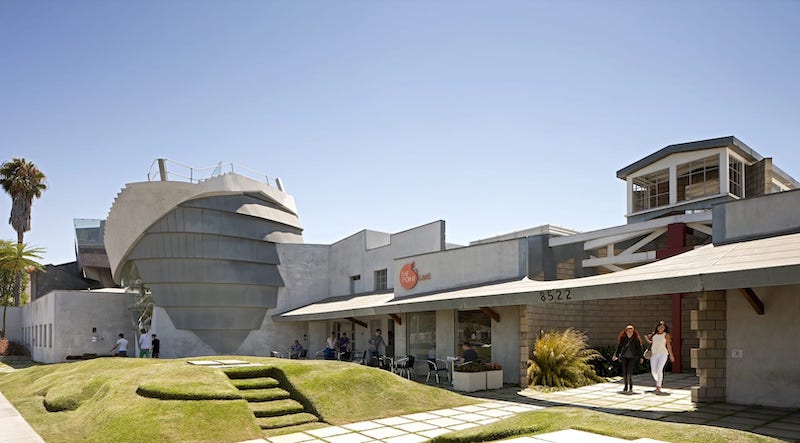The American Institute of Architects (AIA) is honoring Conjunctive Points – The New City, designed by Eric Owen Moss Architects, with its Twenty-five Year Award.
AIA’s Twenty-five Year Award is conferred on a building that has set a precedent for the last 25-35 years and continues to set standards of excellence for its architectural design and significance.
Initiated in 1986 within the Hayden Tract, a former industrial site bounding Central Los Angeles and Culver City, Conjunctive Points – The New City began as simple additions and subtractions to an existing collection of warehouses. With architect Eric Owen Moss designing or renovating one eclectic building at a time, the project set contemporary standards for adaptive re-use, launched the concept of creative office space, and positioned architecture as a method to uncover new social and civic opportunities.
The land developers Frederick and Laurie Samitaur Smith had acquired a significant collection of buildings along the tract, many of which were vacant wood-framed, long-span warehouses and manufacturing spaces. The resulting exchange of ideas across three decades has reversed the area’s plummeting property values and rising crime rates and become a subject of study for the planners, architects, and policy makers who are rethinking cities.
8522 National Boulevard, the first project Moss designed in the Hayden Tract, set the architectural and organizational precedent for what is now known as Conjunctive Points – The New City. At first, Moss’ careful remodels and idiosyncratic buildings with playful, singular names—Umbrella, Beehive, Pterodactyl—attracted small start-ups and young entrepreneurs providing music, graphics, advertising, and post-production services. Since then, major companies such as Nike, Converse, and, most recently, Beats, GoPro, and Apple, have followed in the neighborhood. In an area once devoid of purpose, Conjunctive Points – The New City has prompted significant job creation with an estimated 15,000 newly employed workers flocking there. It remains one of the Los Angeles area’s most desired office locations.
Visit AIA’s website to learn more about the Twenty-five Year Award.
Related Stories
| Apr 5, 2011
Top 10 Buildings: Women in Architecture
Making selections of top buildings this week led to a surprising discovery about the representation of women in architecture, writes Tom Mallory, COO and co-founder, OpenBuildings.com. He discovered that finding female-created architecture, when excluding husband/wife teams, is extremely difficult and often the only work he came across was akin to interior design.
| Apr 5, 2011
What do Chengdu, Lagos, and Chicago have in common?
They’re all “world middleweight cities” that are likely to become regional megacities (10 million people) by 2025—along with Dongguan, Guangzhou, Hangzhou, Shenzhen, Tianjin, and Wuhan (China); Kinshasa (Democratic Republic of the Congo); Jakarta (Indonesia); Lahore (Pakistan); and Chennai (India), according to a new report from McKinsey Global Institute: “Urban World: Mapping the economic power of cities”.
| Mar 30, 2011
China's low-carbon future city
In 2005, the Chinese government announced its target to reduce energy consumption per GDP unit by 20% by the year 2010. After a multi-billion investment, that target has been reached. The Chinese Climate Protection Program’s goal to increase energy efficiency, develop renewable energies, and promote energy savings while reducing pollutant emissions and strengthening environmental protection is reflected in the “Future City” by SBA Design.
| Mar 30, 2011
Is the AEC industry at risk of losing its next generation leaders without better mentoring?
After two or three horrifying years for the AEC industry, we are finally seeing the makings of a turnaround. However, data developed by Kermit Baker as part of the AIA Work-on-the-Boards survey program indicates that between 17% and 22% of design firms are eliminating positions for interns and staff with less than six years of experience. This data suggests the industry is at risk of losing a large segment of its next generation of leaders if something isn't done to improve mentoring across the profession.









